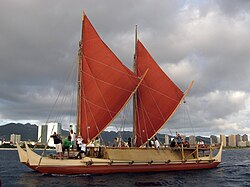
Lakatoi (also Lagatoi) are multiple-hulled [1] sailing watercraft of Papua New Guinea. [2] They are named in the Motu language and traditionally used in the Hiri trade cycle. [3]
Contents
Lakatoi (whose literal meaning is three dugouts) are fashioned from two or more dugout logs fastened together to give stability and cargo-carrying capacity. [1] The two or more dugouts are joined by booms, with a platform built on top. [4] The sail is a crab-claw sail. [5] Horridge (2008) [6] discusses the rig and how the craft is manouvred.








